
On September 23, 24, 25 and 26, 2020, look for the moon in the evening sky, and it’ll guide you to Jupiter and Saturn, our solar system’s two biggest gas giant planets. Given clear skies, you can’t miss these bright worlds. The moon is the second-brightest celestial object, after the sun. And Jupiter is exceptionally bright, too, outshining all the stars (but just a hair less bright than dazzling Mars; more about Mars below). As for Saturn, it’s as bright as the brightest stars. Plus Jupiter and Saturn are noticeable now for their nearness to each other. They’re headed for a great conjunction before 2020 ends.
So you just can’t miss or mistake Jupiter and Saturn near the moon on these evenings. Watch for them!
As viewed from the mainland United States, the moon reaches its first quarter phase on September 23, 2020, at 9:55 p.m. EDT, 8:55 p.m. CDT, 7:55 p.m. MDT and 6:55 p.m. PDT. By Universal Time (UTC), the moon reaches its first quarter phase on September 24, 2020, at 01:55 UTC. At first quarter, the one half of the moon is illuminated in sunshine while the dark half is engulfed in the moon’s own shadow.
The dark side of a waxing moon always points east (the direction of your sunrise). And the moon in its orbit always travels toward the east, too, relative to the sky background. The moon travels about 1/2 degree eastward – its own width on our sky’s dome – every hour.
So – on these evenings in late September 2020 – the moon will go past Jupiter, and then it’ll go by Saturn.
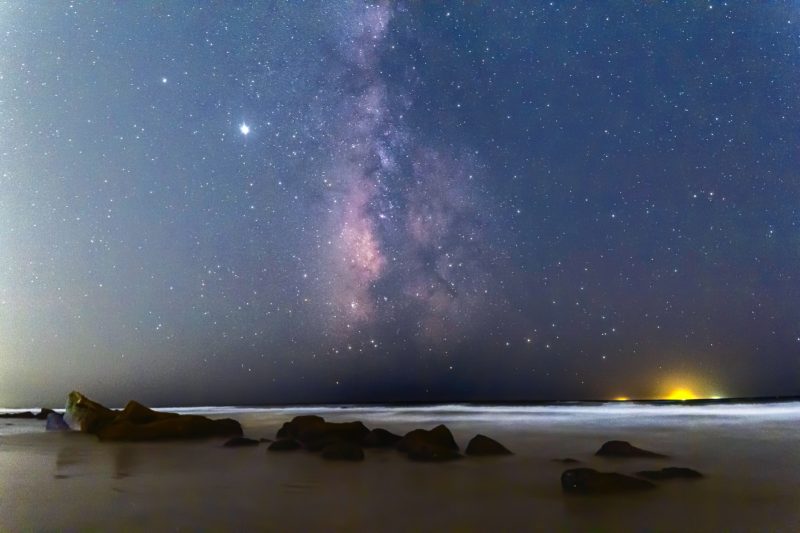
View at EarthSky Community Photos. | Javier Elias captured this image on August 21, 2020, at Costa Ballena Beach in Chipiona, Cadiz, Spain. You can see Jupiter and Saturn to the left of the Milky Way, as the 2 brightest “stars” in the photo. Thank you, Javier.
The moon will swing 1.6 degrees to the south of Jupiter on September 25, 2020, at 06:46 UTC. Then the moon will sweep 2.3 degrees to the south of Saturn on September 25, 2020, at 20:46 UTC. When an almanac gives the degree measure between the moon and a given planet, it means as viewed from the center of the Earth (not the Earth’s surface). Because the moon is close enough to Earth to display a parallax, the angular separation between the moon and planet can vary somewhat around the world.
A word about Mars now. There’s another very bright planet in the September evening sky. It’s Mars, now at its best for this two-year period. As you stand looking at the moon, Jupiter and Saturn, you’ll surely notice Mars to the east (toward your sunrise direction). Earth will pass between Mars and the sun in October, and the planet now outshines Jupiter. The moon will sweep past Mars, too, in late September and early October.
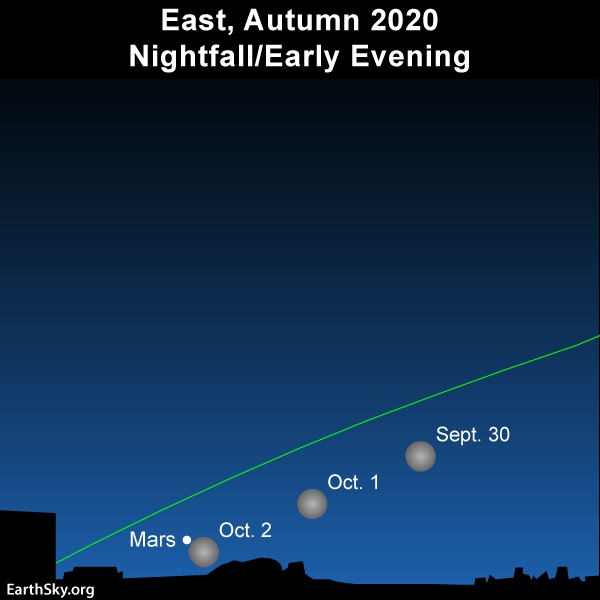
The full Harvest Moon will come on October 1 or 2, 2020, depending on your time zone. It’ll sweep past Mars, now fiery red and very bright! Read more.
Now let’s talk about what you can see through a telescope, if you have one. A telescope, even a modest backyard variety, works like a charm for viewing the moon, Jupiter and Saturn. Dust off that telescope and zoom in to scan the lunar terrain, the four major moons of Jupiter and Saturn’s rings.
The best time to view the moon – with a telescope, binoculars or just your eye – is in twilight. Moon-watching in a dark sky gives you a disadvantage, because the moon’s glare can be overwhelming. As for the best place on the moon to look with a telescope or binoculars, try looking along the terminator line, the shadow line that divides the lunar day from the lunar night. The long shadows along the lunar terminator provide a wondrous three-dimensional portrayal of the lunar mountains, craters and valleys.
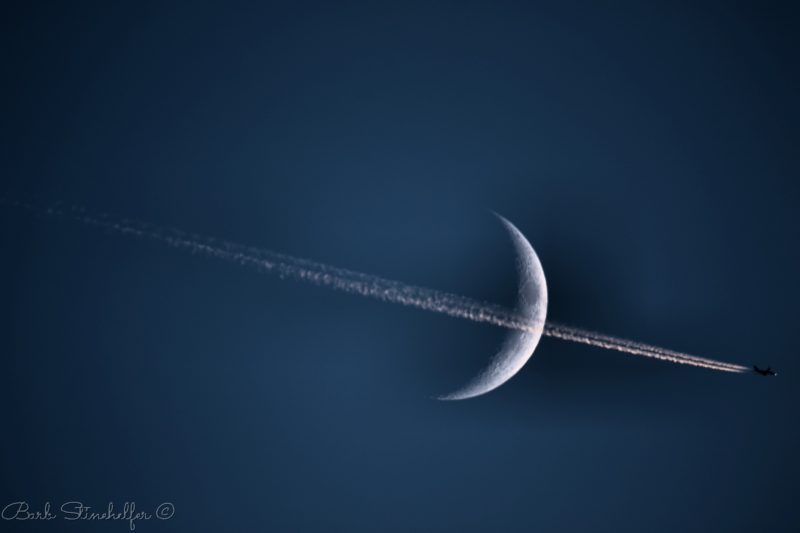
View at EarthSky Community Photos. | Barb Stinehelfer in Upper Sandusky, Ohio, caught this shot on September 20, 2020. She wrote: “19.1% crescent moon complete with surprise photobomber.” Thank you, Barb!
Jupiter’s four major moons – Io, Europa, Ganymede and Callisto – are easy to see in a low-powered telescope, usually appearing as pinpoints of light strung out in a line (really, orbiting Jupiter more or less along a single plane). Sometimes, a moon or two might not be visible, because these Jovian moons regularly pass behind and in front of Jupiter.
Click here to find out the positions of these Galilean moons for right now or some chosen time, via SkyandTelescope.com.

View at EarthSky Community Photos. | Alexander Krivenyshev was creating a 9/11 tribute photo in New York City on September 11, 2020, when he also captured this image of Jupiter and several of its moons. Thank you, Alexander. Visit Sky & Telescope’s Jupiter moon calculator for the present position of Jupiter’s 4 major moons.
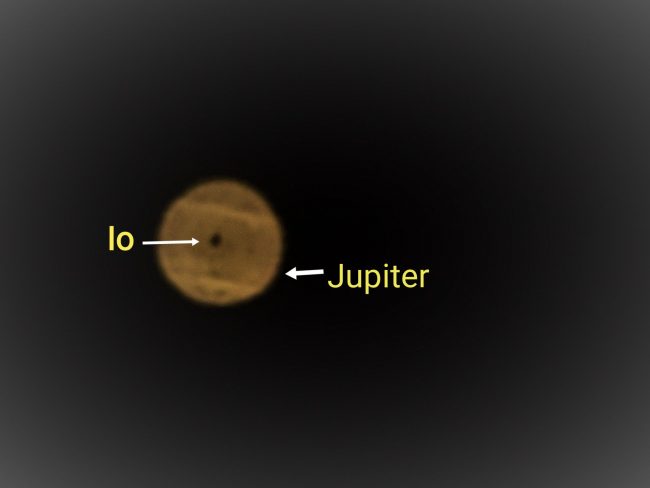
View at EarthSky Community Photos. | Kannan A in Woodlands, Singapore, caught this cool image of Jupiter – with the shadow of the Galilean moon Io cast on the planet – on September 19, 2020. He wrote: “This image of Jupiter was shot from my Nikon camera without the aid of any telescope or additional equipment.” Read more about this photo. Thank you, Kannan A!
Finally, aim your telescope at Saturn to see this planet’s glorious rings, which circle Saturn above this planet’s equator. Fortunately, in 2020, Saturn’s rings appear inclined at around 21 degrees in Earth’s sky, so they are quite easy to see now. There are years (2009, 2025) when Saturn’s rings appear edge-on in Earth’s sky. At those times, the rings become invisible. But not this year, because we enjoy a favorable inclination of the rings in 2020.
Best of all, we can enjoy observing the lunar landscape, Jupiter’s moons and Saturn’s rings in a sky that’s beset with moonlight or light pollution. These solar system wonders don’t demand the dark sky that far-off galaxies and nebulae do.
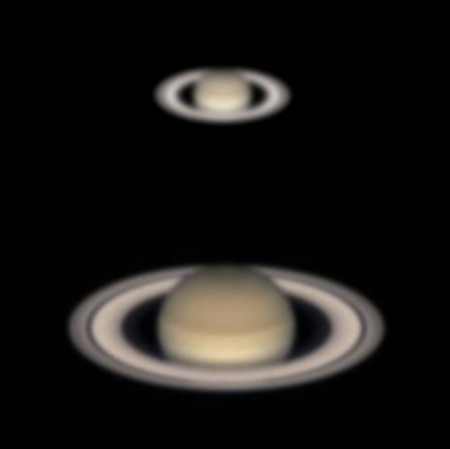
These images suggest how the ringed planet Saturn might look when seen through a 4-inch telescope (top) versus an an 8-inch telescope (bottom). Image via SkyandTelescope.com.
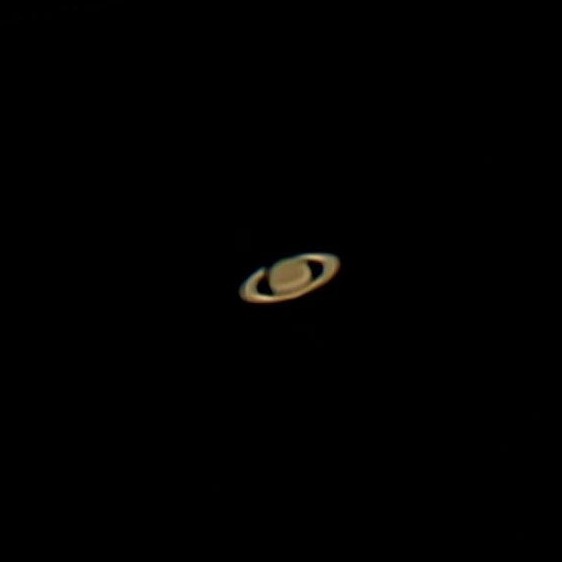
View at EarthSky Community Photos. | Saturn through an 8-inch telescope via Michael Terhune in Lunenburg, Massachusetts. He caught this photo on September 8, 2020, and wrote: “The planet Saturn … not much more to say.” So true! Thank you, Michael!
Bottom line: On September 23, 24, 25 and 26, 2020, use the moon to find the planets Jupiter and Saturn. Have a telescope? Then use it to view Jupiter’s four major moons and Saturn’s glorious rings.
from EarthSky https://ift.tt/35ZvTSY

On September 23, 24, 25 and 26, 2020, look for the moon in the evening sky, and it’ll guide you to Jupiter and Saturn, our solar system’s two biggest gas giant planets. Given clear skies, you can’t miss these bright worlds. The moon is the second-brightest celestial object, after the sun. And Jupiter is exceptionally bright, too, outshining all the stars (but just a hair less bright than dazzling Mars; more about Mars below). As for Saturn, it’s as bright as the brightest stars. Plus Jupiter and Saturn are noticeable now for their nearness to each other. They’re headed for a great conjunction before 2020 ends.
So you just can’t miss or mistake Jupiter and Saturn near the moon on these evenings. Watch for them!
As viewed from the mainland United States, the moon reaches its first quarter phase on September 23, 2020, at 9:55 p.m. EDT, 8:55 p.m. CDT, 7:55 p.m. MDT and 6:55 p.m. PDT. By Universal Time (UTC), the moon reaches its first quarter phase on September 24, 2020, at 01:55 UTC. At first quarter, the one half of the moon is illuminated in sunshine while the dark half is engulfed in the moon’s own shadow.
The dark side of a waxing moon always points east (the direction of your sunrise). And the moon in its orbit always travels toward the east, too, relative to the sky background. The moon travels about 1/2 degree eastward – its own width on our sky’s dome – every hour.
So – on these evenings in late September 2020 – the moon will go past Jupiter, and then it’ll go by Saturn.

View at EarthSky Community Photos. | Javier Elias captured this image on August 21, 2020, at Costa Ballena Beach in Chipiona, Cadiz, Spain. You can see Jupiter and Saturn to the left of the Milky Way, as the 2 brightest “stars” in the photo. Thank you, Javier.
The moon will swing 1.6 degrees to the south of Jupiter on September 25, 2020, at 06:46 UTC. Then the moon will sweep 2.3 degrees to the south of Saturn on September 25, 2020, at 20:46 UTC. When an almanac gives the degree measure between the moon and a given planet, it means as viewed from the center of the Earth (not the Earth’s surface). Because the moon is close enough to Earth to display a parallax, the angular separation between the moon and planet can vary somewhat around the world.
A word about Mars now. There’s another very bright planet in the September evening sky. It’s Mars, now at its best for this two-year period. As you stand looking at the moon, Jupiter and Saturn, you’ll surely notice Mars to the east (toward your sunrise direction). Earth will pass between Mars and the sun in October, and the planet now outshines Jupiter. The moon will sweep past Mars, too, in late September and early October.

The full Harvest Moon will come on October 1 or 2, 2020, depending on your time zone. It’ll sweep past Mars, now fiery red and very bright! Read more.
Now let’s talk about what you can see through a telescope, if you have one. A telescope, even a modest backyard variety, works like a charm for viewing the moon, Jupiter and Saturn. Dust off that telescope and zoom in to scan the lunar terrain, the four major moons of Jupiter and Saturn’s rings.
The best time to view the moon – with a telescope, binoculars or just your eye – is in twilight. Moon-watching in a dark sky gives you a disadvantage, because the moon’s glare can be overwhelming. As for the best place on the moon to look with a telescope or binoculars, try looking along the terminator line, the shadow line that divides the lunar day from the lunar night. The long shadows along the lunar terminator provide a wondrous three-dimensional portrayal of the lunar mountains, craters and valleys.

View at EarthSky Community Photos. | Barb Stinehelfer in Upper Sandusky, Ohio, caught this shot on September 20, 2020. She wrote: “19.1% crescent moon complete with surprise photobomber.” Thank you, Barb!
Jupiter’s four major moons – Io, Europa, Ganymede and Callisto – are easy to see in a low-powered telescope, usually appearing as pinpoints of light strung out in a line (really, orbiting Jupiter more or less along a single plane). Sometimes, a moon or two might not be visible, because these Jovian moons regularly pass behind and in front of Jupiter.
Click here to find out the positions of these Galilean moons for right now or some chosen time, via SkyandTelescope.com.

View at EarthSky Community Photos. | Alexander Krivenyshev was creating a 9/11 tribute photo in New York City on September 11, 2020, when he also captured this image of Jupiter and several of its moons. Thank you, Alexander. Visit Sky & Telescope’s Jupiter moon calculator for the present position of Jupiter’s 4 major moons.

View at EarthSky Community Photos. | Kannan A in Woodlands, Singapore, caught this cool image of Jupiter – with the shadow of the Galilean moon Io cast on the planet – on September 19, 2020. He wrote: “This image of Jupiter was shot from my Nikon camera without the aid of any telescope or additional equipment.” Read more about this photo. Thank you, Kannan A!
Finally, aim your telescope at Saturn to see this planet’s glorious rings, which circle Saturn above this planet’s equator. Fortunately, in 2020, Saturn’s rings appear inclined at around 21 degrees in Earth’s sky, so they are quite easy to see now. There are years (2009, 2025) when Saturn’s rings appear edge-on in Earth’s sky. At those times, the rings become invisible. But not this year, because we enjoy a favorable inclination of the rings in 2020.
Best of all, we can enjoy observing the lunar landscape, Jupiter’s moons and Saturn’s rings in a sky that’s beset with moonlight or light pollution. These solar system wonders don’t demand the dark sky that far-off galaxies and nebulae do.

These images suggest how the ringed planet Saturn might look when seen through a 4-inch telescope (top) versus an an 8-inch telescope (bottom). Image via SkyandTelescope.com.

View at EarthSky Community Photos. | Saturn through an 8-inch telescope via Michael Terhune in Lunenburg, Massachusetts. He caught this photo on September 8, 2020, and wrote: “The planet Saturn … not much more to say.” So true! Thank you, Michael!
Bottom line: On September 23, 24, 25 and 26, 2020, use the moon to find the planets Jupiter and Saturn. Have a telescope? Then use it to view Jupiter’s four major moons and Saturn’s glorious rings.
from EarthSky https://ift.tt/35ZvTSY

Aucun commentaire:
Enregistrer un commentaire